Editor’s Note: Hpathy.com or its editors do not endorse hair-transmission as a way to administer homeopathy remedies. The article has been given space at Hpathy to share with the community one of the non-prescribed ways in which homeopathy remedies are being used.
I am sharing this case with homeopaths to point out three things about the use of homeopathy via hair transmission:
1- Action of remedy is quick if your selection of remedy is correct, be it by any method like classical, therapeutic, pathological, mental or theme based.
2- Homeopathy is also effective in genetically determined diseases.
3 – The method for remedy administration as in all my cases/ clinical practice is Drug Transmission through hair of “Sahni Effect”. This is just another way of administration of a homoeopathic remedy, such as oral, olfaction and touch. This method was discovered by the late Dr. B. Sahni of Patna in 1967. In this method the remedy is not administered by mouth. The dynamic remedy is selected individually, and then one of the patient’s hairs is placed into the remedy solution. By this method the patient receives the effect of the remedy anywhere in the world.
Book on drug transmission
Methodology adopted is as follow:
- Patients is informed of the method.
- Case history is collected from the patients as per the case taking in classical Homoeopathy.
• Each case history is then analyzed for selection of proper rubrics for the selection of the homoeopathic medicines.
• Each case is then repertorized using the RADAR software available at the centre and a medicine is selected.
• A strand of hair is taken, either cut or uprooted, from the head of the patient.
• The selected medicine is used in the 50 millesimal potency and diluted in water in a 5ml vial and ten strokes are given.
• A strand of hair from the patient is inserted in the vial containing the remedy. This is termed “Transmitting set”. It is put in a safe cupboard after labeling it with the name of the medicine, date and patient’s name OR code number allotted to the patient.
• When the hair is put in the vial of transmitting set, it is termed as Transmission “ON” and when the hair is removed from the vial, it is termed Transmission “OFF”
• The patient is advised to report for progress after fifteen days.
• Follow-up progress is noted when the patient revisits the clinic after fifteen days.
• Homoeopathic observation of the case is followed up and change in medicine is made depending on results.
• If no change in symptoms- ten strokes are given to the transmitting set.
• If results are of positive progress, no change is made in the transmitting set.
• If there is aggravation in symptoms, either the hair is removed from the transmitting set or I wait without any change, depending on the progress noted.
• If there are adverse changes, the Transmission is put OFF and I wait for change.
• When there is need to change the remedy, either due to wrong selection or for use of a complementary remedy, the hair is removed from the first transmitting set, properly cleansed and then inserted in a new transmitting set containing a new medicine. - Remedies used for transmission are selected from the general pool of the Homeopathic medicines in 50 millesimal potency.
• Standard homeopathic principles of complementary remedies, follow-up, inimicals, antidotes etc. are followed.
• After treatment is finished or if the patient is not reporting properly, the hair is removed, cleansed and hence drug transmission is stopped.
The advantages of this method are as follows:
- Distance of patient is no bar for patient either in first or subsequent consultations.
• In case of aggravation, simply detaching the hair will check the aggravation.
• It is a continuous process, since the patient receives the remedy as long as the vial contains his hair.
• It is the quickest method of obtaining effects by homoeopathy that I have witnessed in my practice.
• Change of medicine is simple. After washing the hair, it is put it in another medicated vial.
• Patient need not to come our office; he has only to inform us by telephone or message.
• It is a method that can be used in religious fasting like VRAT of Hindus and RAMJAN of Muslims without contradicting religious sentiments of patients
“A Case of Idiopathic Hyperpalmeris”
Dr. Ravi Singh
This patient was suffering with Hyperlinearis Palmaris since childhood. Drug Transmission of Mezereumium 0/1 has worked like a miracle in just 28 days.
He first visited on 04/06/2016 where I saw this case of Hypelinear palm with Ichthyosis like symptoms on feet , clearly visible in photographs.
Mezereumium was selected as the drug of choice and mode of administration was Sahni Effect or Drug Transmission through hair. ( Please visit the link http://raviclinic.com/Drug_Transmission_Through_Hair.html and for a video https://youtu.be/ienjZfv8wRU )
The patient’s two brothers were also suffering from similar symptoms. This point also confirmed that this is a case of Ichthyosis . I started drawing analogy with the pathophysiology and appearance of Mezereum and referred to Clark’s Practical Dictionary of M.M. There I found a few indications under Mezereum. Sensitiveness to touch, general desquamation of skin, liver spots on chest and arms become dark and desquamate, ulcers easily bleeding when removing the linen, the pus forms an adherent scab, suppuration after inflammation. The prescription was largely based on my experience. I have treated many cases of Ichthyosis which responded well to Mezereum. The eruptions (ichthyosis) of feet were starting to bleed due to a secondary infection.
We transmitted Mezereumium 0/1 with the patients hair on 04/06/2016
A wonderful recovery was observed in the first month . Treatment continued….
The point to ponder here is, Ichthyosis is a genetic disorder and Ichthyosis Vulgaris is one of the more commonly seen types of Ichthyosis. Sometimes called common Ichthyosis (“vulgar” means “common” in Latin), it appears in approximately 1 in 250 individuals. Ichthyosis vulgaris often goes undiagnosed because people who have it think they have simple “dry skin” and never seek treatment. In ichthyosis vulgaris, the skin cells are produced at a normal rate, but they do not separate normally at the surface of the stratum corneum (the outermost layer of skin) and are not shed as quickly as they should be. The result is a buildup of scales. Usually only a portion of the body may be involved (scaling is most common and most severe over the lower legs), and the scale is usually fine and white. Scaling on the torso is usually less severe and the face is usually unaffected. When the face is affected, the scaling is usually limited to the forehead and cheeks.
Babies with ichthyosis vulgaris often appear normal when they are born, but then the skin abnormalities will almost always show up by their first birthday. Ichthyosis vulgaris may improve in certain climates, during the summer and with age.
UPDATE




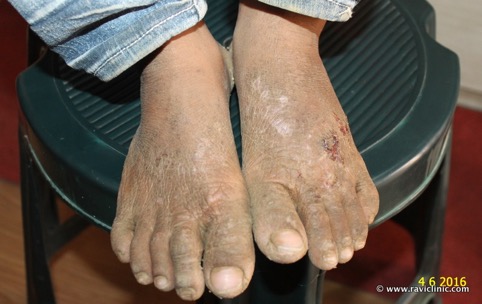

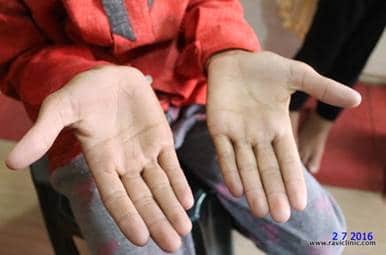

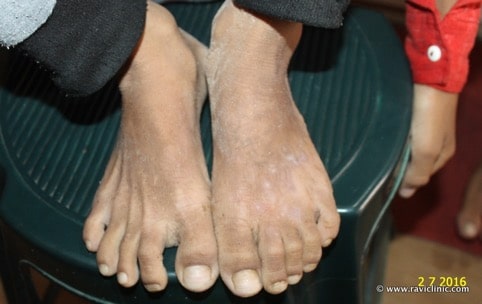



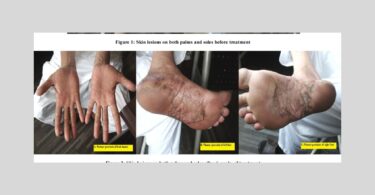

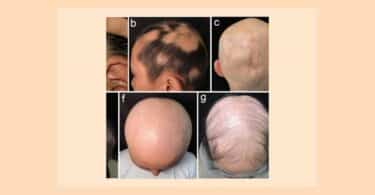
Dear Mr. Singh,
I’m very interested to try out this Method but I have a question to the Potency you use. Is it the Same that I know Here in Germany as a C 50.000 ? And do you use always that high Potency?
Trank you for your great article,
Dr. Christoph Roggendorf
Amazing sirjiiii
Superb
Thank you for sharing your hairtransmission case, I have been dispensing this way for close to 18 yrs. Sadly not many practicioners are open minded to this method of moving energy medicine (homeopathy). Keep up your great work
DEAR DR,
WITH DUE RESPECT I WANT TO STATE THAT 40 YEARS OR SO BACK I MET THE DR WHO ORIGINATED THIS METHOD OF ROOT OF THE HAIR PULLED FROM THE HEAD OF THE PATIENTS AND AND DIPPED THE ROOT HALF INSIDE AND HALF OUT SIDE IN A SELECTED REMEDY KEPT IN HIS CLINIC IN VARIOUS POTENCY AS PER THE NEED IN HIS OPINION. AT THAT TIME HE DID NOT TELL ME THAT HAIR ROOT METHOD IS ONLY USED IN SKIN DISEASES. I USED THIS METHOD FOR SOMETIME IN ALL CASES/DISEASES BUT DID NOT GET MUCH SUCCESS. IN CASE SOME OTHER HOMEOPATHS ARE FOLLOWING THIS METHOD, PL LET ME KNOW THEIR % OF SUCCESS AND ANY OTHER INFORMATION WHICH I MISSED IN MY PRACTICE THEN I WOULD LIKE TO ADMIRE THOSE WHO ARE USING THIS METHOD WITH SUCCESS.
THANKS
This is rubbish!! what is next? think of a remedy and you will get cured??
Is it possible to treat kidney failure patients with this